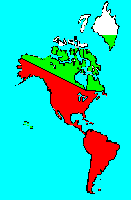SPECIES INFO
Shasta ground sloth (Northrotheriops shastensis) began its career in South America, but migrated to North America about one million years ago. These sloths were found as far north as Alberta, Canada. They have been extinct since about 10,780 years ago. Arizona has yielded fossils from between 40,000 and 11,000 years ago. This sloth was around 9 feet long and weighed between 300 and 400 pounds.
In an article by Betsy Mason in August 2005 in Science, she presents a very strong argument that mankind drove the giant ground sloths to extinction. The argument, which we have also seen elsewhere, relies on a new kind of spear point that came into being about the time of the giant mammal extinctions in North America. Recent diggings show these spear points adjacent to the bones with similar time frames.Browsing ground Sloths (Family Megatheriidae) are a family of mammals that contained some gigantic forms that weighed over six thousand pounds. All the members of this family are now extinct.
Anteaters, sloths, and armadillo found in warm and tropical areas of the New World are combined into a single order, Edentata. The pangolins of the Old World were sometimes placed here, but we have kept them in a separate order in line with recent publications (2004) by Duff and Lawson.
An extinct group of turtle like mammals called glyptodonts can belong here. Furthermore, in very recent times, several gigantic sloths existed.
In Gardner's Mammals of South America as published in 2007, he has combined the armadillos, sloths, and anteaters into a magnorder Xenarthra. He then creates the order Cingulata for the armadillos and the order Pilosa for the sloths and anteaters.
Mammals (Class Mammalia), together with the birds, are among the youngest of the classes of animals. In species count, mammals number about fifty-one hundred, trailing reptiles (approximately fifty-five hundred), fish (approximately eighteen thousand), and birds (approximately eighty-six hundred).
There are three sub-types of mammals:
monotremes, the most primitive:
Develop in reptilian-like eggs and suckle milk emerging
(i.e., spiny anteater, duckbilled platypus)
marsupials
Newborn emerges very underdeveloped and continue to
mature in a pouch on its mother's abdomen (i.e., opossums,
koala, kangaroo)
placental
Embryo develops within the uterus of the female and is
dependent on a placenta for nutrition and waste removal
(i.e., humans, lions, monkeys)
About sixty-five million years ago, the Tertiary era produced thirty-five orders of mammals. Of this number, eighteen have survived to represent Earth's most diversified as well as its most highly developed classification of animals.
Extinction of mammals is fast becoming a serious issue. Duff and Lawson present a list of forty-one extinct species that reached extinction prior to 1800. These forty-one species are not acknowledged in the counts of the various families. Duff and Lawson also present a list of forty-six species including three gazelles, one zebra, one seal, one deer, and one wolf that have probably gone extinct since 1800. These forty-six species are included in the family counts. Science is adding about forty to fifty new species a year to the list. Many of these are the result of divisions of prior species; some are recent discoveries.
Mammals owe their survival to adaptive capabilities that include the ability to exploit whatever sources of food are available to them, as well as their ability to adjust to various climes. Food specialization influenced evolution to such a great extent that the teeth structure can and has been used to provide extensive information on the food needs and various lifestyles of extinct species.
Despite the vast diversity among mammals in terms of size, habitats and adaptations, they share without exception many characteristics such as:
a. body hair
b. mammary glands
c. certain skull characteristics
d. four limbs that permit speed
e. parallel not perpendicular limbs
f. compartmentalized internal organs
g. a four-chambered heart and pulmonary circulation
Backboned Animals (Phylum Chordata) are the most advanced group of animals on earth. These animals are characterized by having a spinal cord or backbone. Most members have a clearly defined brain that controls the organism through a spinal cord. Fish, amphibians, reptiles, birds, and mammals are in this phylum.
Currently, some taxonomists believe that the fish should be divided into two groups (sharks and regular fishes) and that there are some other primitive groups in the phylum such as hagfish or lampreys.
Animal Kingdom contains numerous organisms that feed on other animals or plants. Included in the animal kingdom are the lower marine invertebrates such as sponges and corals, the jointed legged animals such as insects and spiders, and the backboned animals such as fish, amphibians, reptiles, birds, and mammals.

